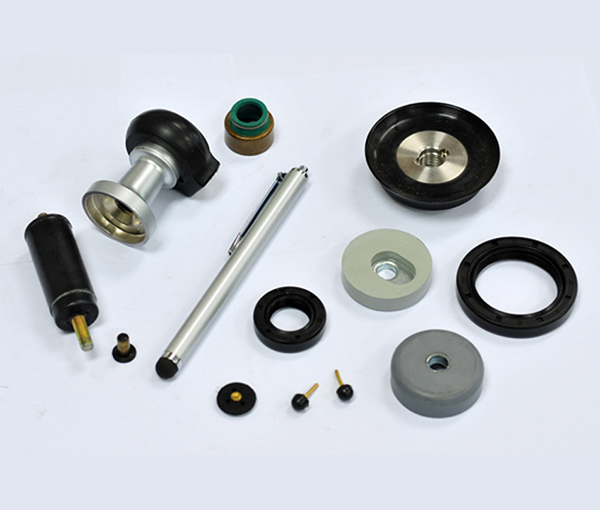-
National consultation hotline:
13590252450 / 18676388050


Time:2024-05-09 Preview:1
Hello everyone, I am the editor. Today I will introduce you to rubber sealing rings. The following content is compiled by the editor and the relevant content is for reference only.

1. NBR nitrile rubber seal ring:
Suitable for use in petroleum hydraulic oil, glycol hydraulic oil, diester lubricating oil, gasoline, water, silicone grease, silicone oil and other media. It is currently the most widely used and lowest cost rubber seal. It is not suitable for polar solvents such as ketones, ozone, nitro hydrocarbons, MEK and chloroform. The general use temperature range is -40 to 120 ℃.
2. HNBR hydrogenated nitrile rubber seal ring:
It has excellent corrosion resistance, tear resistance and compression deformation resistance, and has good ozone resistance, sunlight resistance and weather resistance. It has better wear resistance than nitrile rubber. It is suitable for washing machinery and automobile engine systems. It is not recommended to use in alcohol, ester or aromatic solutions. The general use temperature range is -40 to 150 ℃.
3. SIL silicone rubber seal ring:
It has excellent heat resistance, cold resistance, ozone resistance and atmospheric aging resistance. It has good insulation properties. But its tensile strength is worse than that of general rubber and it is not oil-resistant. It is suitable for household appliances such as electric water heaters, electric irons, microwave ovens, etc. It is also suitable for various items that come into contact with the human body, such as kettles, water dispensers, etc. It is not recommended to use in most concentrated solvents, oils, concentrated acids and sodium hydroxide. The general operating temperature range is -55 to 250 °C.
4. VITON fluororubber seal ring:
Its high temperature resistance is better than silicone rubber, and it has excellent weather resistance, ozone resistance and chemical resistance, but poor cold resistance. It has resistance to most oils and solvents, especially acids, aliphatic hydrocarbons, aromatic hydrocarbons and animal and vegetable oils. It is suitable for the sealing needs of diesel engines, fuel systems and chemical plants. It is not recommended to use ketones, low molecular weight esters and mixtures containing nitric acid. The general operating temperature range is -20 to 250 °C.
5. FLS fluorosilicone rubber seal ring:
Its performance combines the advantages of fluororubber and silicone rubber, and it is resistant to oil, solvents, fuel oil, high and low temperature. It can resist the erosion of oxygen-containing compounds, aromatic hydrocarbon solvents and chlorine-containing solvents. The general use temperature range is -50 to 200 ℃.
6. EPDM ethylene propylene diene monomer rubber seal ring:
It has good weather resistance, ozone resistance, water resistance and chemical resistance. It can be used for alcohols and ketones, and can also be used for sealing in high-temperature water vapor environments. The general use temperature range is -55 to 150 ℃.
7. CR chloroprene rubber seal ring:
It has excellent sunlight resistance and weather resistance. It is not afraid of refrigerants such as dichlorodifluoromethane and ammonia, and is resistant to dilute acids and silicone grease lubricants, but it expands a lot in mineral oils with low aniline points. It is easy to crystallize and harden at low temperatures. It is suitable for various environments exposed to the atmosphere, sunlight, ozone, and various flame-resistant and chemical corrosion-resistant sealing links. It is not recommended to use in strong acids, nitro hydrocarbons, esters, chloroform and ketones. The general use temperature range is -55 to 120 °C.
8. IIR butyl rubber seal:
It has excellent air tightness, heat resistance, sunlight resistance, ozone resistance, and good insulation performance; it has good resistance to polar solvents such as alcohols, ketones, esters, etc., and can be exposed to animal and vegetable oils or oxidizable substances. Suitable for chemical resistance or vacuum equipment. It is not recommended to use it with petroleum solvents, kerosene or aromatics. The general use temperature range is -50 to 110 °C.
9. ACM acrylic rubber seal:
It has excellent resistance to oil products, high temperature resistance and weather resistance, but its mechanical strength, compression deformation rate and water resistance are slightly poor. It is generally used in automobile transmission systems and power steering systems. It is not suitable for hot water, brake oil, and phosphate esters. The general use temperature range is -25 to 170 °C.
10. NR natural rubber seal ring:
Rubber products have good wear resistance, elasticity, tear strength and elongation. But it is easy to age in the air, becomes sticky when heated, and is easy to swell and dissolve in mineral oil or gasoline. It is alkali-resistant but not resistant to strong acid. It is suitable for use in liquids with hydroxide ions such as automobile brake oil and ethanol. The general use temperature range is -20 to 100 ℃.
11. PU polyurethane rubber seal ring:
The mechanical properties of polyurethane rubber are very good, and its wear resistance and high pressure resistance are far better than other rubbers. It also has good aging resistance, ozone resistance and oil resistance, but it is easy to hydrolyze at high temperature. It is generally used in high-pressure and wear-resistant sealing links. The general use temperature range is -45 to 90 ℃.
If you want to know more about the industry information of rubber seal rings, please log in to our official website and we will bring you more practical tips.